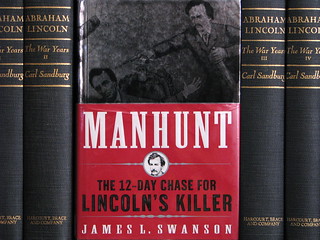I’m always impressed when a writer takes a familiar story and inflates it with details I never knew. Textbooks edit history for brevity — after all, how many high school kids want to read two hundred pages when two paragraphs will do? But so much drama gets lost in the process. The loss is probably the chief reason many people think history is boring: Just facts and dates; no story.
 Researchers can find a tremendous amount of detail among old documents, though, and breathe a story back into the bland facts. Take James Swanson’s Manhunt: The 12-Day Chase for Lincoln’s Killer, for instance. Nearly everyone knows the basics: Young actor John Wilkes Booth shot Abraham Lincoln while the president watched a play from the balcony of Ford’s Theater on the first Friday evening after the South surrendered the Civil War. A couple weeks later Booth was cornered and killed in a Virginia barn. Textbook facts, right?
Researchers can find a tremendous amount of detail among old documents, though, and breathe a story back into the bland facts. Take James Swanson’s Manhunt: The 12-Day Chase for Lincoln’s Killer, for instance. Nearly everyone knows the basics: Young actor John Wilkes Booth shot Abraham Lincoln while the president watched a play from the balcony of Ford’s Theater on the first Friday evening after the South surrendered the Civil War. A couple weeks later Booth was cornered and killed in a Virginia barn. Textbook facts, right?
It turns out there was plenty of drama in the intervening twelve days. So much, in fact, that if you didn’t know this book was history, you’d think it was written as a movie screenplay draft. It’s got all the basics of a flick featuring a bad guy on the lam with investigators in pursuit. But this is history — done with an engaging narrative.
Swanson begins the story just before the crime, early in the day before Booth learned that the First Couple would be attending the theater. The author then leads his reader through the city of Washington as Booth hatches his plan, conspires with others, and sets everything into motion. Most of the book follows the trail of Booth and a fellow fugitive making their way across the farmlands of Maryland and Virginia. It also keeps up on the progress of the chase put together by military detectives and soldiers.
The picture painted by Swanson is rich with detail and actual quotations (derived from investigations and testimonies). You’d think there had been a camera crew along with the fugitives to document everything: from Booth’s bridge crossing past the guards on the first night, through his hiding five days in a pine thicket, to the many encounters with strangers who aided and abetted him along the way. The 25-year old Booth was a somewhat well-known actor before the assassination of Lincoln, but was known (at least by name and description) by everyone in the days following. The army was looking for him — yet there were those who helped (or at least didn’t hinder) him. One former Confederate intelligence officer single-handedly thwarted the manhunt by hiding the fugitives in the pine thicket.
There’s Booth and fellow fugitive David Herold sitting, talking, and relaxing on the porch bench at Garrett’s Farm. I’m not saying it’s a sympathetic figure — he wasn’t, and his treatment of the few people who didn’t immediately assist him demonstrated that — but it’s a scene I had never considered.
I like history but not “textbook history”. The most fascinating stories are often edited out of textbooks for brevity. With the deleted words, much of the drama is cut, too. It takes detailed books like this one, focusing on one interesting event, to energize the facts and dates we learned in high school.

